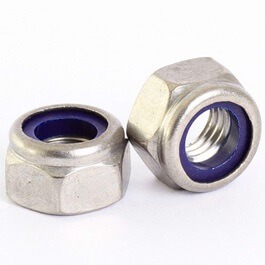How Do Nyloc Nuts Work?
Nyloc nuts feature a nylon collar in the top portion of the nut that locks the nut in place by essentially squeezing the threads of the bolt as the nut is tightened. In scientific terms, the friction that is created by the radial compressive force of the nut turning against the thread prevents it from loosening.
The name Nyloc is short for Nylon insert lock nut. They are also sometimes called polymer-insert lock nuts, or elastic stop nuts.
| NYLOC NUTS |
 |
One of the advantages of Nyloc nuts is that unlike lock washers they are unaffected by vibration.
When using a nyloc nut, always inspect the nylon insert first to ensure that it is not damaged.
Nyloc nuts should be threaded onto the bolt or stud and tightened by hand until resistance is felt. Continue tightening through this resistance with a spanner or socket until the nut seats firmly against the surface of the object that you are securing.
Nyloc nuts can be re-used but it is not advisable, as their efficiency is reduced with every application until eventually, they become ineffective. The effective operating temperature of Nyloc nuts varies by manufacturer but as a rule of thumb, we would advise extremes of -40C to +120C.
The thread on this type of nut can often (but not always!) be identified by the colour of the nylon insert, with blue signifying metric and white for imperial threads.

